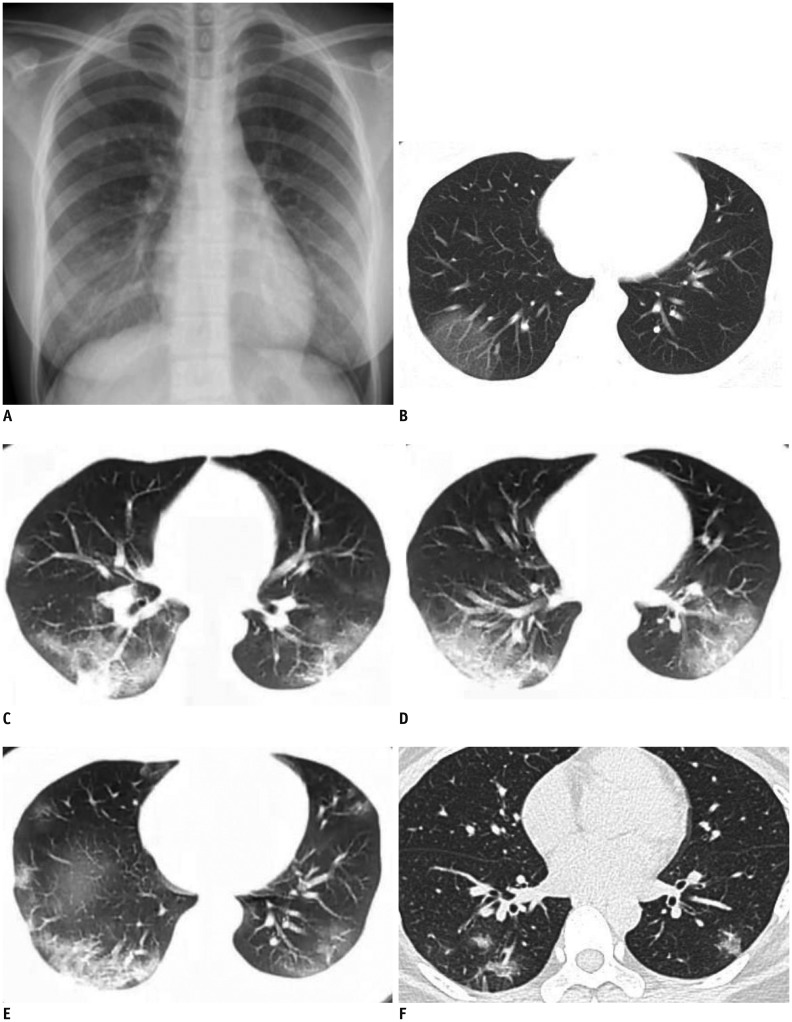Korean J Radiol.
2020 Apr;21(4):501-504. 10.3348/kjr.2020.0112.
2019 Novel Coronavirus (COVID-19) Pneumonia: Serial Computed Tomography Findings
- Affiliations
-
- 1Department of Radiology, Jiangxi Provincial People's Hospital, Nanchang, China. 26171381@qq.com
- 2Department of Medical Cosmetology, Jiangxi Provincial People's Hospital, Nanchang, China.
- 3Department of Radiology, Jiangxi Chest Hospital, Nanchang, China.
- 4Institute of Clinical Medicine, Jiangxi Provincial People's Hospital, Nanchang, China.
- KMID: 2471816
- DOI: http://doi.org/10.3348/kjr.2020.0112
Abstract
- From December 2019, Coronavirus disease 2019 (COVID-19) pneumonia (formerly known as the 2019 novel Coronavirus [2019-nCoV]) broke out in Wuhan, China. In this study, we present serial CT findings in a 40-year-old female patient with COVID-19 pneumonia who presented with the symptoms of fever, chest tightness, and fatigue. She was diagnosed with COVID-19 infection confirmed by real-time reverse-transcriptase-polymerase chain reaction. CT showed rapidly progressing peripheral consolidations and ground-glass opacities in both lungs. After treatment, the lesions were shown to be almost absorbed leaving the fibrous lesions.
Keyword
MeSH Terms
Figure
Reference
-
1. Rubin EJ, Baden LR, Morrissey S, Campion EW. Medical journals and the 2019-nCoV outbreak. N Engl J Med. 2020; 1. 27. [Epub]. DOI: 10.1056/NEJMe2001329.
Article2. The Lancet. Emerging understandings of 2019-nCoV. Lancet. 2020; 395:311. PMID: 31986259.3. Carlos WG, Dela Cruz CS, Cao B, Pasnick S, Jamil S. Novel Wuhan (2019-nCoV) Coronavirus. Am J Respir Crit Care Med. 2020; 201:P7–P8. PMID: 32004066.
Article4. Lei J, Li J, Li X, Qi X. CT imaging of the 2019 Novel Coronavirus (2019-nCoV) pneumonia. Radiology. 2020; 1. 31. [Epub]. DOI: 10.1148/radiol.2020200236.5. Zhu N, Zhang D, Wang W, Li X, Yang B, Song J, et al. China Novel Coronavirus Investigating and Research Team. A novel coronavirus from patients with pneumonia in China, 2019. N Engl J Med. 2020; 1. 24. [Epub]. DOI: 10.1056/NEJMoa2001017.
Article6. Lu H. Drug treatment options for the 2019-new Coronavirus (2019-nCoV). Biosci Trends. 2020; 1. 28. [Epub]. DOI: 10.5582/bst.2020.01020.
Article7. Corman VM, Landt O, Kaiser M, Molenkamp R, Meijer A, Chu DK, et al. Detection of 2019 novel Coronavirus (2019-nCoV) by real-time RT-PCR. Euro Surveill. 2020; 25:2000045.
Article
- Full Text Links
- Actions
-
Cited
- CITED
-
- Close
- Share
- Similar articles
-
- Clinical and Radiologic Findings of COVID-19 Pneumonia: South Korean Experience from Three Cases
- Mediastinal Emphysema, Giant Bulla, and PneumothoraxDeveloped during the Course of COVID-19 Pneumonia
- Pulmonary Contusion Similar to COVID-19 Pneumonia
- Small Solitary Ground-Glass Nodule on CT as an InitialManifestation of Coronavirus Disease 2019 (COVID-19)Pneumonia
- Novel Coronavirus Pneumonia Outbreak in 2019: Computed Tomographic Findings in Two Cases


